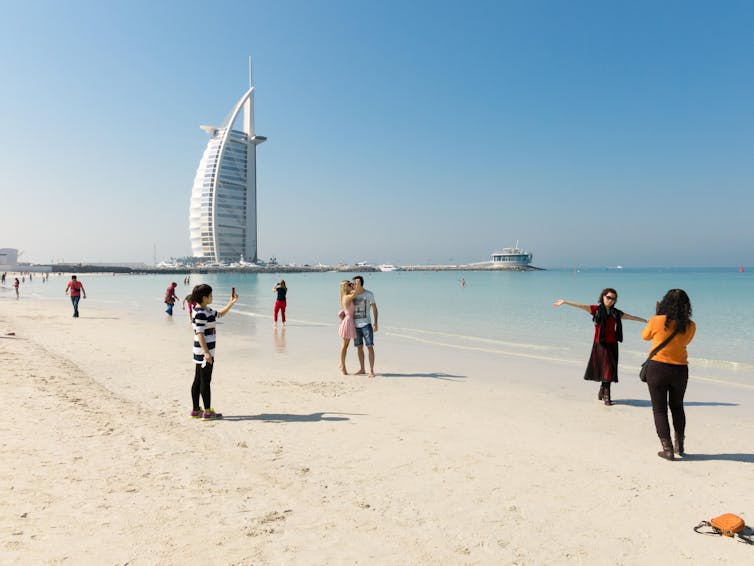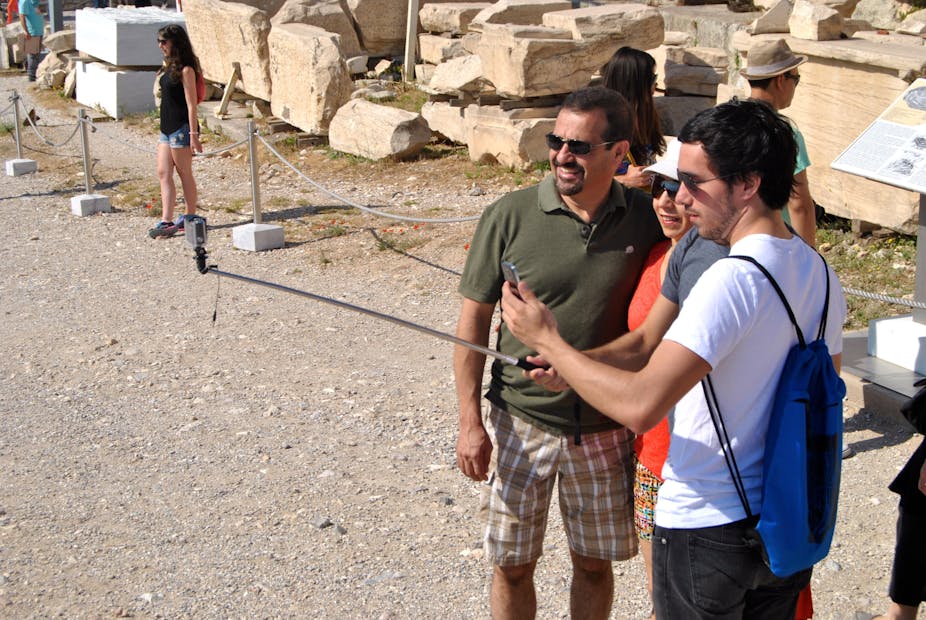A town in the US state of Vermont closed its roads to tourists in September 2023 after a social media tag sparked a swarm of visitors that overwhelmed the rural destination.
Videos on TikTok were seen by thousands and the hashtag #sleepyhollowfarm went viral, prompting a tourist rush to the pretty New England town of Pomfret, where visitors tried to take photos of themselves against the countryside backdrop. The town, famous for its fall foliage, criticised this as problematic and “influencer tourism”, part of a travel trend where a social media phenomenon can spark an overwhelming and unexpected rise in visitor numbers.
Traditionally, we think of tourists as travelling to gain new experiences. They look at sites, take photographs and collect souvenirs. However, this relationship between the tourist and touring is changing.
Driven by 24-hour access to social media, some tourists now travel primarily to have an experience that looks good online. Around 75% of people in a recent American Express survey said they had been inspired to visit somewhere by social media. Some tourists may be prompted to choose a destination by seeing a backdrop that is popular on social media or on television, in order to create a high-status photo.
The expansion of social media and ubiquity of smartphone cameras has had a major impact on tourists’ behaviour. This has also led to what’s been called a selfie “tourist gaze”, creating photos where the traveller is at the forefront of images rather than the destination.
Indeed, according to my research, increasingly, some tourists go somewhere to be spotted – to be observed by others both online and in person at these destinations.
Looking for drama
Studies have highlighted how tourists head for particularly dramatic or luxurious destinations because of their social media links. Dubai, for example, with its bling culture and high-end shopping, has become a playground for influencers looking for a luxury backdrop to add to their celebrity-style image.

Some tourists aim to photograph themselves in prestigious locations, rather than taking shots of their travel surroundings. Others choose to act like mini-celebrities and perform for the camera, expecting and wanting to be looked at by those they encounter – or even narrating their participation in extreme events.
One of these is the Rickshaw Run, a 2,000km race across India. This adventure tourism event encourages participants to dress up, act eccentrically and get noticed. Driving tuk-tuks around India, from Kerala to Darjeeling, vehicles are personalised with eye-catching designs. Many participants film themselves and upload the results to social media, and the events tend to create a significant following. For instance, this YouTube video series created by Rickshaw Run participants drew 3.6m subscribers:
However, some of these tourist “performances” can cause controversy. For instance, climbing over fragile archaeological sites in search of social media content might damage them. Posing for laughs in areas considered sacred can offend. The reducing of cultures to backdrops for social media content can suggest a lack of interest in or respect for hosts by tourists.
My research points to a growth in narcissism in society, and connects this with what tourists desire from travel and how they act when travelling. This may be reflected in increased sense of entitlement and exhibitionism by tourists who aim to take photos in more difficult to reach locations or off-limit areas, for instance.
Selfie culture arguably promotes self-involvement rather than social responsibility. It is well established that tourists can be selfish, putting their own comfort and entertainment ahead of concerns about local issues. This is especially true of the super-rich. Private jet users are responsible for half of global aviation emissions.
Read more: Sustainable tourism needs to be built with the help of locals
However, the desire to promote the individual and their values could be harnessed to promote more sustainable tourism. Those volunteering abroad might be motivated by the image enhancement opportunities of doing good, but they often offer something back to the social and natural environments of their host destinations in the process.
There are signs that there’s another tourism trend, with travellers looking for deep and meaningful experiences, and ecotourism could help provide those. The act of travelling in a more environmentally friendly way could also be seen as a way to show off, and still provide selfie material.
The environmental pros and cons of tourist self-obsession might be debatable. However, self-fixation is arguably not good for tourists themselves. For example, the desire to “perform” on camera could affect people’s mental health, according to one study.
Research has shown that unexpected encounters help tourists to gain self-insight. In addition, getting out of your comfort zone can lead to rewarding personal growth.
A disconnect between self and place
Taking yet more selfies could cut people off from their surroundings. In doing so, they could be less present in the travel experience itself. Indeed, the growing number of selfie-related tourist deaths might attest to a disconnect between self and place. A 2018 report estimated 259 deaths to have occurred while taking selfies between 2011-2017.
Other research suggests that individuals who are motivated by the desire to present a particular online image may be more likely to take risks with their travel selfies, with potentially fatal consequences.
Tourists have always been somewhat self-obsessed. The 18th-century Grand Tour, a leisurely trip around Europe, allowed the wealthy to indulge themselves in ways that might not have been socially acceptable back home. And at the beginning of the 21st century, academics worried about self-involved backpacker communities in southeast Asia having little interest in mixing with local people.
What is different about smartphones and social media is that these allow some tourists to present such self-indulgent, and sometimes insensitive, tourism traits immediately. Wifi and mobile data mean that these tourists can travel with one eye on finding the perfect selfie backdrop – filtering and sharing their travel as it happens, responding to likes and comments.
For better or worse, living this influencer fantasy may have become an integral part of tourism for some time.

